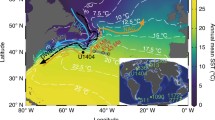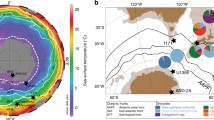Abstract
The ice core glacial-interglacial record of the last 450 kyr (Cortese et al. Paleogeogr Paleoclimatol 22:4, 2007), development of cold ice meltwater regions at fringes of the Greenland and the West Antarctic ice sheets, and climate projections by Hansen et al. (Atmos Chem Phys 16:3761–3812, 2016), support a relation between ice sheet melting and the cooling of neighboring ocean zones by ice meltwater. Several factors lead to cooling of parts of the North Atlantic Ocean and adjacent lands, including the following: (A) a slowdown of the Atlantic meridional overturning circulation (AMOC); (B) flow of cold ice meltwater from the Greenland ice sheet into the North Atlantic Ocean; (C) undulation and weakening of the jet stream at the Arctic boundary due to a rise in temperature in the Arctic circle at twice the rate of warming at lower latitudes and the ice-water albedo flip. Penetration of Arctic-derived cold air masses southward through a weakened jet stream boundary ensues in extreme weather events in North America and Europe. The slowdown of the AMOC (Caesar et al. Nature 556:191–196, 2018; Praetorius Nat Clim Chang 5:475–480, 2018; Thornalley et al. Nature 556:227–230, 2018; Smeed et al. Geophys Res Lett 45(3):1527–1533, 2018) and growing cold ocean region (Rahmstorf et al. Nat Clim Chang 5:475–480, 2015) may herald the onset of a stadial event. A large-scale stadial event, possibly on the scale of the 8.3–8.2 kyr-old Laurentian melt event, or even the 12.9–11.7-kyr-old Younger Dryas stadial (Carlson Encycl Quat Sci 3:126–134, 2013), could ensue from advanced melting of both the Greenland ice sheet and the Antarctic ice sheet. A stadial would be succeeded by the resumption of warming driven by a continuing rise in greenhouse gas concentrations and amplifying feedback effects. These projections need to be examined vis-a-vis the continuous linear IPCC temperature rise models.







Similar content being viewed by others
Notes
1 Sv = 106 m3 s−1
Where a small amount of melting creates a film of water on top of ice, the water absorbs infrared radiation and melts more ice, leading to runaway melting of the ice sheet
1 Sv = 106m3 s−1
References
Alley RB (2000) Ice-core evidence of abrupt climate changes. Proc Nat Assoc Sci 97(4):1331–1334
Bingham RJ et al (2007) Meridional coherence of the North Atlantic meridional overturning circulation. Geoph Res Lett 34:L23606
Broecker WS (2000) Abrupt climate change: causal constraints provided by the paleoclimate record. Earth Sci Rev 51:137–154
Caesar L, Rahmstorf S, Robinson A, Feulner G, Sab V (2018) Observed fingerprint of a weakening Atlantic Ocean overturning circulation. Nature 556:191–196
Canadell JG (2009) Super-size deposits of frozen carbon threat to climate change. Proc Am Assoc Adv Sci https://www.eurekalert.org/pub_releases/2009-06/gcp-sdo_1063009.php
Canadell JG et al (2007) Contributions to accelerating atmospheric CO2 growth from economic activity, carbon intensity and efficiency of natural sinks. Proc Nat Acad Sci 104:18866–18870
Carlson AE (2013) The Younger Dryas climate event. Encycl Quat Sci 3:126–134
Cortese G, Abelmann A, Gersonde A (2007) The last five glacial-interglacial transitions: a high-resolution 450,000-year record from the sub-Antarctic Atlantic. Paleogeogr Paleoclimatol 22:4
Easterbrook S (2014) We have to choose which future we want very soon. New IPCC Report (Part 6) Azimuth Project https://johncarlosbaez.wordpress.com/2014/04/16/what-does-the-new-ipcc-report-say-about-climate-change-part-6/
Foukal NP, Lozier MS (2018) Examining the origins of ocean heat content variability in the eastern North Atlantic subpolar gyre. Geophys Res Lett 45:11275–11283
Frajka-Williams E (2015) Estimating the Atlantic overturning at 26°N using satellite altimetry and cable measurements. Geoph Res Lett 42:3458–3464
Hansen J (2018) Climate change in a nutshell: the gathering storm. Earth Institute – Columbia University http://csas.ei.columbia.edu/2018/12/18/climate-change-in-a-nutshell-the-gathering-storm-2/
Hansen J et al (2013) Climate sensitivity, sea level and atmospheric carbon dioxide. Philos Trans A Math Phys Eng Sci 371(2001)
Hansen J et al (2016) Ice melt, sea level rise and superstorms: evidence from paleoclimate data, climate modeling, and modern observations that 2°C global warming could be dangerous. Atmos Chem Phys 16:3761–3812
IPCC (2013) Two decades of the Atlantic meridional overturning circulation: anatomy, variations, extremes, prediction, and overcoming its limitations. https://journals.ametsoc.org/doi/abs/10.1175/JCLI-D-12-00478.1
IPCC (2015) Global Temperature Part 2: Future Projections http://climatesmartnetwork.org/2015/03/global-temperature-part-2-future-projections/
IPCC AR5 WGI (2015) Chapter 12 global temperature part 2: future projections. http://climatesmartnetwork.org/2015/03/global-temperature-part-2-future-projections/
Karspeck AR et al (2017) Comparison of the Atlantic meridional overturning circulation between 1960 and 2007 in six ocean reanalysis products. Clim Dyn 49:957–982
Kürschner WM (2008) The impact of Miocene atmospheric carbon dioxide fluctuations on climate and the evolution of terrestrial ecosystems. Proc Nat Assoc Science 105(2):449–453
Lewis CFM et al (2012) Lake Agassiz outburst age and routing by Labrador Current and the 8.2 kyr cold event. Quat Int 260:83–97
Liu et al (2017) Overlooked possibility of a collapsed Atlantic meridional overturning circulation in warming climate. Sci Adv 3(1):e1601666
Matero et al (2017) The 8.2 kyr cooling event caused by Laurentide ice saddle collapse. Earth Planet Sci Lett 473:205–214
NASA (2018) 2018 is only halfway over, but a troubling climate change trend is already apparent. https://mashable.com/article/global-warming-trend-nasa-charts/#VepvpgqlSaqk
Praetorius SK (2018) North Atlantic circulation slows down. Nature 556:180–181
Rahmstorf S et al (2015) Exceptional twentieth-century slowdown in Atlantic Ocean overturning circulation. Nat Clim Chang 5:475–480
Rignot E et al (2011) Acceleration of the contribution of the Greenland and Antarctic ice sheets to sea level rise. Geophys Res Lett 38(5)
Rignot E et al (2018) Mass balance of the Antarctic ice sheet from 1992 to 2017. Nature 558:219–222
Sallee JB (2018) Southern Ocean warming. Oceanography 31(2):52–62
Shepherd A et al. (The IMBIE team) (2018) Mass balance of the Antarctic ice sheet from 1992 to 2017. Nature 558: 219–222
Smeed DA et al (2018) The North Atlantic Ocean is in a state of reduced overturning. Geophys Res Lett 45(3):1527–1533
Steffen W et al (2017) Trajectories of the earth system in the Anthropocene. PNAS 115(33):8252–8259
Steffensen JP et al (2008) High-resolution Greenland ice core data show abrupt climate change happens in few years. Science 321(5889):680–684
Thornalley DJR et al (2018) Anomalously weak Labrador Sea convection and Atlantic overturning during the past 150 years. Nature 556:227–230
Velicogna I et al (2014) Regional acceleration in ice mass loss from Greenland and Antarctica using GRACE time-variable gravity data. Geophys Res Lett 41(22):8130–8137
Wagner F, Aaby B, Visscher H (2002) Rapid atmospheric CO2 changes associated with the 8,200-years-B.P. cooling event. Proc Natl Acad Sci U S A 99:12011–12014
Weaver AJ et al (2012) Stability of the Atlantic meridional overturning circulation: a model inter-comparison. Geophys Res Lett 39(20)
Acknowledgments
I am grateful to the reviewers for comprehensive in-depth comments and contributions to the manuscript. I thank Will Steffen for his comments. Brenda McAvoy has kindly proof read the paper. I thanks Prof James Hansen for permission to cite figures and John Wiley and Son for permission to cite Fig. 4.
Author information
Authors and Affiliations
Corresponding author
Additional information
Publisher’s note
Springer Nature remains neutral with regard to jurisdictional claims in published maps and institutional affiliations.
Rights and permissions
About this article
Cite this article
Glikson, A.Y. North Atlantic and sub-Antarctic Ocean temperatures: possible onset of a transient stadial cooling stage. Climatic Change 155, 311–321 (2019). https://doi.org/10.1007/s10584-019-02458-x
Received:
Accepted:
Published:
Issue Date:
DOI: https://doi.org/10.1007/s10584-019-02458-x




